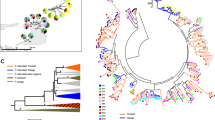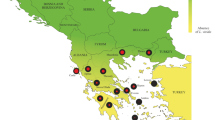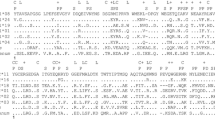Abstract
Balancing selection acting over the evolutionary history of a lineage can result in the retention of alleles among species for longer than expected under neutral evolution. The associated pattern of trans-species polymorphism, in which similar or even identical alleles are shared among species, is often used to infer that balancing selection has occurred. The genes of the major histocompatibility complex (MHC) are thought to be subject to balancing selection that maintains alleles associated with response to specific pathogens. To explore the role of balancing selection in shaping MHC diversity in ctenomyid rodents, we examined allelic variability at the class II DRB and DQA loci in 18 species in the genus Ctenomys. Previous studies of four of these species had revealed significant within-population evidence of positive selection on MHC loci. The current study expands upon these analyses to (1) evaluate among-species evidence of positive selection and (2) explore the potential for balancing selection on MHC genes. Interspecific nucleotide sequence variation revealed significant evidence of positive selection on the DRB and DQA loci. At the same time, comparisons of phylogenetic trees for these MHC loci with a putative species tree based on mitochondrial sequence data revealed multiple examples of trans-specific polymorphism, including sharing of identical DRB and DQA alleles among distantly related species of Ctenomys. These findings suggest that MHC genes in these animals have historically been subject to balancing selection and yield new insights into the complex suite of forces shaping MHC diversity in free-living vertebrates.


Similar content being viewed by others
References
Anisimova M, Bielawski JP, Yang Z (2001) Accuracy and power of the likelihood ratio test to detect adaptive molecular evolution. Molecular Biology and Evolution 18:1585–1592
Anisimova M, Nielsen R, Yang Z (2003) Effect of recombination on the accuracy of the likelihood method for detecting positive selection at amino acid sites. Genetics 164:1229–1236
Bradley RD, Hillis DM (1997) Recombinant DNA sequences generated by PCR amplification. Molecular Biology and Evolution 14:592–593
Brown JH, Jardetzky T, Saper MA et al (1988) A hypothetical model of the foreign antigen binding site of class II histocompatibility molecules. Nature 332:845–850
Brown JH, Jardetzky TS, Gorga JC, Stern LJ, Urban RG, Strominger JL, Wiley DC (1993) Three-dimensional structure of the human class II histocompatibility antigen HLA-DR1. Nature 364:33–39
Bryja J, Galan M, Charbonnel N, Cosson JF (2006) Duplication, balancing selection and trans-species evolution explain the high levels of polymorphism of the DQA MHC class II gene in voles (Arvicolinae). Immunogenetics 58:191–202
Busch C, Antinuchi CD, del Valle JC, Kittlein MJ, Malizia AI, Vassallo AI, Zenuto RR (2000) Population ecology of subterranean rodents. In: Lacey EA, Cameron G, Patton JL (eds) Life underground: the biology of subterranean rodents. The University of Chicago Press, Chicago, IL, pp 183–226
Castillo AH, Cortinas MN, Lessa EP (2005) Rapid diversification of South American tuco-tucos (Ctenomys; Rodentia, Ctenomyinae): contrasting mitochondrial and nuclear intron sequences. J Mammal 86:170–179
Cook JA, Lessa EP (1998) Macroevolutionary patterns of diversification in subterranean rodents. The case of the South American tuco-tucos (genus Ctenomys, Rodentia: Octodontidae). Evolution 52:1521–1527
Cutrera AP (2007) Estudio de la variación genética neutral y adaptativa en Ctenomys sp. (Rodentia: Ctenomyidae): los roles de la demografía y de la historia. PhD thesis, Universidad Nacional de Mar del Plata, Mar del Plata, Argentina
Cutrera AP, Lacey EA (2006) MHC variation in talar tuco-tucos: the influence of demography on selection. J Mammal 87:706–716
Cutrera AP, Lacey EA, Busch C (2005) Genetic structure in a solitary rodent (Ctenomys talarum): implications for kinship and dispersal. Mol Ecol 14:2511–2523
Cutrera AP, Lacey EA, Busch C (2006) Intraspecific variation in effective population size in tuco-tucos (Ctenomys talarum): The role of demography. J Mammal 87:108–116
D’Elia G, Lessa EP, Cook JA (1999) Molecular phylogeny of tuco-tucos, genus Ctenomys (Rodentia: Octodontidae): evaluation of the mendocinus species group and the evolution of asymmetric sperm. J Mamm Evol 6:9–38
Doherty PC, Zinkernagel RF (1975) Enhanced immunological surveillance in mice heterozygous at the H-2 complex. Nature 256:50–52
Doxiadis GGM, Roweler AJM, de Groot NG, Louwerse A, Otting N, Verschoor EJ, Bontrop RE (2006) Extensive sharing of MHC class II alleles between rhesus and cynomolgus macaques. Immunogenetics 58:259–268
Edwards SV, Chestnut K, Satta Y, Wakeland EK (1997) Ancestral polymorphism of MHC class II genes in mice: implications for balancing selection and the mammalian molecular clock. Genetics 146:655–668
Figueroa F, Gunther E, Klein J (1988) MHC polymorphism predating speciation. Nature 335:265–267
Garrigan D, Hedrick PW (2003) Detecting adaptive molecular polymorphism: lessons from the MHC. Evolution 57:1707–1722
Goldman N, Yang Z (1994) A codon-based model of nucleotide substitution for protein-coding DNA sequences. Mol Biol Evol 11:725–736
Hambuch TM, Lacey EA (2002) Enhanced selection for MHC diversity in social tuco-tucos. Evolution 56:841–845
Hedrick PW (1999) Balancing selection and MHC. Genetica 104:207–214
Hedrick PW, Kim TJ (2000) Genetics of complex polymorphisms: parasites and maintenance of the major histocompatibility complex variation. In: Singh RS, Krimbas CB (eds) Evolutionary genetics: from molecules to morphology. Cambridge Univ. Press, Cambridge, UK, pp 204–234
Hedrick PW, Thomson G (1983) Evidence for balancing selection at HLA. Genetics 104:449–456
Hedrick PW, Parker KM, Gutierrez-Espeleta GA, Rattink A, Lievers K (2000) Major histocompatibility complex variation in the Arabian oryx. Evolution 54:2145–2151
Hedrick PW, Parker KM, Lee RN (2001a) Using microsatellite and MHC variation to identify species, ESUs, and MUs in the endangered Sonoran topminnow. Mol Ecol 10:1399–1412
Hedrick PW, Kim TJ, Parker KM (2001b) Parasite resistance and genetic variation in the endangered Gila topminnow. Anim Conserv 4:103–109
Huelsenbeck JP, Ronquist F (2001) MrBAYES: Bayesian inference of phylogenetic trees. Bioinformatics 17:754–755
Hughes AL (1999) Adaptive evolution of genes and genomes. Oxford University Press, New York
Hughes A, Hughes M (1995) Natural selection on the peptide–binding regions of major histocompatibility complex molecules. Immunogenetics 42:233–243
Hughes AL, Nei M (1988) Pattern of nucleotide substitution at major histocompatibility complex class I loci reveals overdominant selection. Nature 335:167–179
Hughes AL, Nei M (1989) Nucleotide substitution at major histocompatibility complex class II loci: evidence for overdominant selection. Proc Nat Acad Sci 86:958–962
Hughes AL, Yeager M (1998) Natural selection and the evolutionary history of major histocompatibility complex loci. Front Biosci 3:d509–516
Janeway CA, Travers P (1999) Immunobiology: the immune system in health and disease, 4th edn. Current Biology, London
Kenter M, Otting N, Anholts J, Jonker M, Schipper R, Bontrop RE (1992) Mhc-DRB diversity of the chimpanzee (Pan troglodytes). Immunogenetics 37:1–11
Klein J (1980) Generation of diversity at MHC loci: implications for T-cell receptors repertoires. In: Fougereau M, Dausset J (eds) Immunology 80. Academic, London, pp 239–253
Klein J (1986) Natural history of the major histocompatibility complex. Wiley, New York
Klein J (1987) Origin of the major histocompatibility complex polymorphism: the trans-species hypothesis. Hum Immunol 19:155–162
Klein J, Sato A, Nagl S, O’huigin C (1998) Molecular trans-species polymorphism. Ann Rev Ecolog Syst 29:1–21
Kundu S, Faulkes CG (2007) A tangled history: patterns of major histocompatibility complex evolution in the African mole-rats (Family: Bathyergidae). Biol J Linn Soc 91:493–503
Lacey EA (2000) Spatial and social systems of subterranean rodents. In: Lacey EA, Patton JL, Cameron GN (eds) Life underground: the biology of subterranean rodents. The University of Chicago Press, Chicago and London, pp 257–296
Lacey EA (2001) Microsatellite variation in solitary and social tuco-tucos: molecular properties and population dynamics. Heredity 86:628–637
Lacey EA, Cutrera AP (2007) Behavior, demography, and immunogenetic variation: new insights from subterranean rodents. In: Begall S, Burda H, Schleich C (eds) Subterranean rodents: news from underground. Springer, Heidelberg, pp 343–356
Lessa EP, Cook JA (1998) The molecular phylogenetics of tuco-tucos (genus Ctenomys, Rodentia: Octodontidae) suggests an early burst of speciation. Mol Phylogenet Evol 9:88–99
Marshall LG, Sempere T (1993) Evolution of the neotropical cenozoic land mammal fauna in its eochronologic, stratigraphic, and tectonic context. In: Goldblatt P (ed) Biological relationships between Africa and South America. Yale University Press, New Haven, CT, pp 329–392
McVean GAT, Awadalla P, Fearnhead P (2002) A coalescent-based method for detecting and estimating recombination from gene sequences. Genetics 160:1231–1241
Meyer D, Thomson G (2001) How selection shapes variation of the human major histocompatibility complex: a review. Ann Hum Genet 65:1–26
Mones A, Castiglioni LR (1979) Additions to the knowledge on fossil rodents of Uruguay (Mammalia: Rodentia). Paleontologische Zeitschrift 53:77–87
Musolf K, Meyer-Lucht Y, Sommer S (2004) Evolution of MHC-DRB class II polymorphism in the genus Apodemus and a comparison of DRB sequences within the family Muridae (Mammalia: Rodentia). Immunogenetics 56:420–426
Nagl S, Tichy H, Mayer WE, Takahata N, Klein J (1998) Persistence of neutral polymorphisms in Lake Victoria cichlid fish. Proc Nat Acad Sci U S A 95:14238–14243
Nielsen R, Yang Z (1998) Likelihood models for detecting positively selected amino acid sites and applications to the HIV-1 envelope gene. Genetics 148:929–936
Otting N, de Groot NG, Doxiadis GGM, Bontrop RE (2002) Extensive MHC-DQB variation in humans and non-human primate species. Immunogenetics 54:230–239
Penn DJ, Potts WK (1999) The evolution of mating preferences and major histocompatibility complex genes. The American Naturalist 153(2):145–164
Posada D, Crandall KA (1998) Modeltest: testing the model of DNA substitution. Bioinformatics 14(9):817–818
Quintana CA (1994) Ctenominos primitivos (Rodentia, Ocotodontidae) del Mioceno de la Provincia de Buenos Aires, Argentina. Boletín de la Real Academia Española de Historia Natural (Sección Geología) 89:19–23
Radwan J, Kawalko A, Wojcik JM, Babik W (2007) MHC-DRB3 variation in a free-living population of the European bison, Bison bonasus. Mol Ecol 16:531–540
Sawyer SA (1999) GENECONV: a computer package for statistical detection of gene conversion. http://www.math.wustl.edu/~sawyer/mbprogs/
Scharf SJ, Long CM, Erlich HA (1988) Sequence analysis of the HLA DR beta and HLA DQ beta loci from the Pemphigus vulgaris patients. Hum Immunol 22:61–69
Schaschl H, Suchentrunk F, Hammery S, Goodman SJ (2005) Recombination and the origin of sequence diversity in the DRB MHC class II locus in chamois (Rupicapra spp.). Immunogenetics 57:108–115
Schaschl H, Wandeler P, Suchentrunk F, Obexer-Ruff G, Goodman SJ (2006) Selection and recombination drive the evolution of MHC class II DRB diversity in ungulates. Heredity 97:427–437
Schultz PH, Zarate M, Hames H, Camilion C, King J (1998) A 3.3-Ma impact in Argentina and possible consequences. Science 282:2061–2063
Seddon JM, Baverstock PR (1999) Variation on islands: major histocompatibility complex (Mhc) polymorphism in populations of the Australian bush rat. Mol Ecol 8:2071–2079
Seddon JM, Ellegren H (2002) MHC class II genes in European wolves: a comparison with dogs. Immunogenetics 54:490–500
Slade RW, Moritz C, Heideman A, Hale PT (1993) Rapid assessment of single-copy nuclear DNA variation in diverse species. Mol Ecol 2:359–373
Slade RW, Hale PT, Francis DI, Marshall Graves JA, Sturm RA (1994) The marsupial MHC: the tammar wallaby, Macropus eugenii, contains an expressed DNA-like gene on chromosome 1. J Mol Evol 38:496–505
Slamovits CH, Cook JA, Lessa EP, Rossi MS (2001) Recurrent amplifications and deletions of satellite DNA accompanied chromosomal diversification in South American tuco-tucos (genus Ctenomys, Rodentia: Octodontidae): a phylogenetic approach. Mol Biol Evol 18:1708–1719
Sommer S, Schwab D, Ganzhorn JU (2002) MHC diversity of endemic Malagasy rodent in relation to geographic range and social system. Behav Ecol Sociobiol 51:214–221
Steinberg EK, Patton JL (2000) Genetic structure and the geography of speciation in swubterranean rodents: opportunities and constraints for evolutionary diversification. In: Lacey EA, Patton JL, Cameron GN (eds) Life underground: the biology of subterranean rodents. The University of Chicago Press, Chicago and London, pp 301–331
Swofford DL (ed) (2002) PAUP*. Phylogenetic analysis using parsimony (*and other methods), version 4. Sinauer Associates, Sunderland, MA
Takahata N, Nei M (1990) Allelic genealogy under over-dominant and frequency-dependent selection and polymorphism of major histocompatibility complex loci. Genetics 124:967–978
Van Den Bussche RA, Hoofer SR, Lochmiller RL (1999) Characterization of Mhc-DRB allelic diversity in white-tailed deer (Odocoileus virginianus) provides insight into Mhc-DRB allelic evolution within Cervidae. Immunogenetics 49:429–437
Verzi DH (2002) Patrones de evolucion morfológica en Ctenomyinae (Rodentia: Octodontidae). Mastozoolgía Neotropical 9:309–328
Wilson DJ, McVean G (2006) Estimating diversifying selection and functional constraint in the presence of recombination. Genetics 172:1411–1425
Yang Z (1997) PAML: a program for package for phylogenetic analysis by maximum likelihood. CABIOS 15:555–556
Yang Z (2001) Adaptive molecular evolution. In: Balding D, Bishop M, Cannings C (eds) Handbook of statistical genetics, Chap. 12. Wiley, London, pp 327–350
Yang Z, Nielsen R, Goldman N, Pedersen AMK (2000) Codon-substitution models for heterogeneous selection pressure at amino acid sites. Genetics 155:431–449
Yang Z, Wong WSW, Nielsen R (2005) Bayes Empirical Bayes inference of amino acid sites under positive selection. Mol Biol Evol 22:1107–1118
Acknowledgment
We thank David Vieites for his invaluable assistance with the phylogenetic analyses and Enrique Lessa and two anonymous reviewers for insightful comments on previous versions of this manuscript. We particularly wish to thank Tina Hambuch for her pioneering studies of MHC variation in ctenomyids. Financial support was provided by the Universidad Nacional de Mar del Plata, the Agencia de Promoción Científica y Tecnológica (FONCYT-PICT 01–09846), the National Science Foundation (DEB-9704462 and DEB-0128857), and CONICET (Beca Doctoral Mixta to APC). All field procedures conformed to guidelines of the American Society of Mammalogists for the capture, handling, and care of mammals (Animal Care and Use Committee 1998).
Author information
Authors and Affiliations
Corresponding author
Rights and permissions
About this article
Cite this article
Cutrera, A.P., Lacey, E.A. Trans-species polymorphism and evidence of selection on class II MHC loci in tuco-tucos (Rodentia: Ctenomyidae). Immunogenetics 59, 937–948 (2007). https://doi.org/10.1007/s00251-007-0261-3
Received:
Accepted:
Published:
Issue Date:
DOI: https://doi.org/10.1007/s00251-007-0261-3




